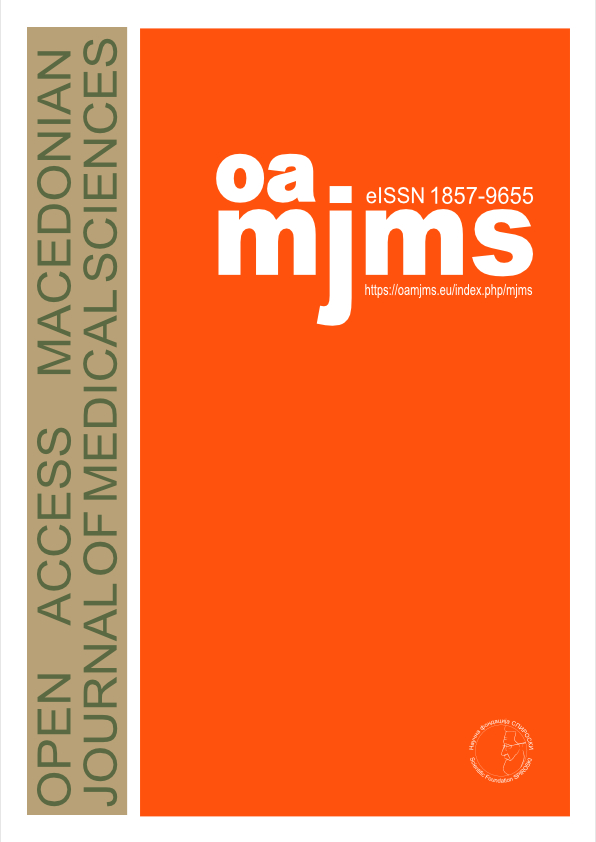Clinical Characteristics and Some Related Factors in Children with Prurigo Nodularis in Vietnam
DOI:
https://doi.org/10.3889/oamjms.2024.11955Keywords:
Clinical characteristics, Children, Prurigo nodularis, Related factors, TreatmentAbstract
BACKGROUND: Prurigo nodularis in children can become chronic, lasting from several months to many years, triggered and sustained by environmental allergens. In Vietnam, prurigo nodularis is relatively common; however, few studies have been conducted on pediatric populations.
AIMS: This study aims to describe the clinical characteristics and related factors of prurigo nodularis in children.
METHODS: This prospective, cross-sectional descriptive study was conducted at the National Hospital of Dermatology and Venereology from December 2023 to June 2024. A total of 117 children participated in the study. Data were collected according to the study’s medical record template.
RESULTS: The results showed that the proportion of male patients was higher than that of female patients (62.4% vs. 37.6%), with the highest proportion of cases in the under-6 age group (47%). Most patients lived in urban areas (88%). Nearly half of the cases had disease duration of < 12 months (42.2%). The onset rate on the legs was the highest (58.2%). Some related factors were herbal baths (1.7%), food allergies (8.5%), pet keeping (22.2%), insect bites (23.1%), family history of prurigo (24.8%), long fingernails (59.8%), and self-medication (73.5%). The rate of regular deworming was 93.2% of the children. Most patients experienced severe itching (97.4%), with the severity and activity level of the disease mainly at moderate levels (96.6% and 97.4%, respectively).
CONCLUSION: Prurigo nodularis in children presents with diverse clinical characteristics. Factors such as food allergies, pet keeping, insect bites, and family history may play a role in triggering and maintaining the disease, but further research is needed.
Downloads
Metrics
Plum Analytics Artifact Widget Block
References
Satoh T, Yokozeki H, Murota H, Tokura Y, Kabashima K, Takamori K, et al. 2020 guidelines for the diagnosis and treatment of prurigo. J Dermatol. 2021;48(9):e414-31. https://doi.org/10.1111/1346-8138.16067 PMid: 34314056 DOI: https://doi.org/10.1111/1346-8138.16067
Williams KA, Roh YS, Brown I, Sutaria N, Bakhshi P, Choi J, et al. Pathophysiology, diagnosis, and pharmacological treatment ofprurigonodularis.ExpertRevClinPharmacol.2021;14(1):67-77. https://doi.org/10.1080/17512433.2021.1852080 PMid:33191806 DOI: https://doi.org/10.1080/17512433.2021.1852080
Dégboé B, Koudoukpo C, Maffo N, Otémé S, Kouassi A, Akpadjan F, et al. Prurigo in children of tropical zone: Epidemiological, clinical, and etiological characteristics in a dermatology department in Cotonou (Benin). Dermatol Res Pract. 2019;2019:2673981. https://doi.org/10.1155/2019/2673981 PMid:31781184 DOI: https://doi.org/10.1155/2019/2673981
Albela H, Leong KF. Early-onset, severe prurigo nodularis in a young child with atopic dermatitis treated successfully with dupilumab. Indian J Paediatr Dermatol. 2022;23(2):170-1. https://doi.org/10.4103/ijpd.ijpd_175_21 DOI: https://doi.org/10.4103/ijpd.ijpd_175_21
Oliveira J, Nogueira M, Pinto D, Machado S, Araújo AR, Teixeira F. Role of dupilumab in pediatric prurigo nodularis: Beyond the skin. Pediatr Allergy Immunol. 2023;34(1):e13912. https://doi.org/10.1111/pai.13912 PMid:36705041 DOI: https://doi.org/10.1111/pai.13912
Huang AH, Roh YS, Sutaria N, Choi J, Williams KA, Pritchard T, et al. Real-world disease burden and comorbidities of pediatric prurigo nodularis. J Am Acad Dermatol. 2022;86(3):655-7. https://doi.org/10.1016/j.jaad.2021.02.030 PMid:33600911 DOI: https://doi.org/10.1016/j.jaad.2021.02.030
Qureshi AA, Abate LE, Yosipovitch G, Friedman AJ. A systematic review of evidence-based treatments for prurigo nodularis. J Am Acad Dermatol. 2019;80(3):756-64. https://doi.org/10.1016/j.jaad.2018.09.020 PMid:30261199 DOI: https://doi.org/10.1016/j.jaad.2018.09.020
Thai NQ. Study on the association between prurigo nodularis and metabolic diseases at the department of Dermatology, Thai Nguyen hospital. Vietnamese J Dermatol Venereol. 2012;2:8-16.
Zeidler C, Yosipovitch G, Ständer S. Prurigo nodularis and its management. Dermatol Clin. 2018;36(3):189-97. https://doi.org/10.1016/j.det.2018.02.003 PMid:29929592 DOI: https://doi.org/10.1016/j.det.2018.02.003
Kwon CD, Khanna R, Williams KA, Kwatra MM, Kwatra SG. Diagnostic workup and evaluation of patients with prurigo nodularis. Medicines (Basel). 2019;6(4):97. https://doi.org/10.3390/medicines6040097 PMid:31561504 DOI: https://doi.org/10.3390/medicines6040097
Yosipovitch G, Reaney M, Mastey V, Eckert L, Abbé A, Nelson L, et al. Peak pruritus numerical rating scale: Psychometric validation and responder definition for assessing itch in moderate-to-severe atopic dermatitis. Br J Dermatol. 2019;181(4):761-9. https://doi.org/10.1111/bjd.17744 PMid:30729499 DOI: https://doi.org/10.1111/bjd.17744
Zeidler C, Pereira MP, Augustin M, Spellman M, Ständer S. Investigator’s global assessment of chronic prurigo: A new instrument for use in clinical trials. Acta Derm Venereol. 2021;101(2):adv00401. https://doi.org/10.2340/00015555-3701 PMid:33236125 DOI: https://doi.org/10.2340/00015555-3701
Maridet C, Perromat M, Miquel J, Chiaverini C, Bessis D, Lasek A, et al. Childhood chronic prurigo: Interest in patch tests and delayed-reading skin prick tests to environmental allergens. J Allergy Clin Immunol. 2018;141(2):797-9.e9. https://doi.org/10.1016/j.jaci.2017.07.049 PMid:28943471 DOI: https://doi.org/10.1016/j.jaci.2017.07.049
Iking A, Grundmann S, Chatzigeorgakidis E, Phan NQ, Klein D, Ständer S. Prurigo as a symptom of atopic and non- atopic diseases: Aetiological survey in a consecutive cohort of 108 patients. J Eur Acad Dermatol Venereol. 2013;27(5):550-7. https://doi.org/10.1111/j.1468-3083.2012.04481.x PMid:22364653 DOI: https://doi.org/10.1111/j.1468-3083.2012.04481.x
Pereira MP, Lüling H, Dieckhöfer A, Steinke S, Zeidler C, Ständer S. Brachioradial pruritus and notalgia paraesthetica: A comparative observational study of clinical presentation and morphological pathologies.Acta Derm Venereol. 2018;98(1):82-8. https://doi.org/10.2340/00015555-2789 PMid:28902951 DOI: https://doi.org/10.2340/00015555-2789
Hughes JDM, Woo TE, Belzberg M, Khanna R, Williams KA, Kwatra MM, et al. Association between prurigo nodularis and etiologies of peripheral neuropathy: Suggesting a role for neural dysregulation in pathogenesis. Medicines (Basel). 2020;7(1):4. https://doi.org/10.3390/medicines7010004 PMid:31936197 DOI: https://doi.org/10.3390/medicines7010004
Downloads
Published
How to Cite
License
Copyright (c) 2024 Sar Sokpharuth, Thi Huyen Tran (Author)

This work is licensed under a Creative Commons Attribution-NonCommercial 4.0 International License.
http://creativecommons.org/licenses/by-nc/4.0







